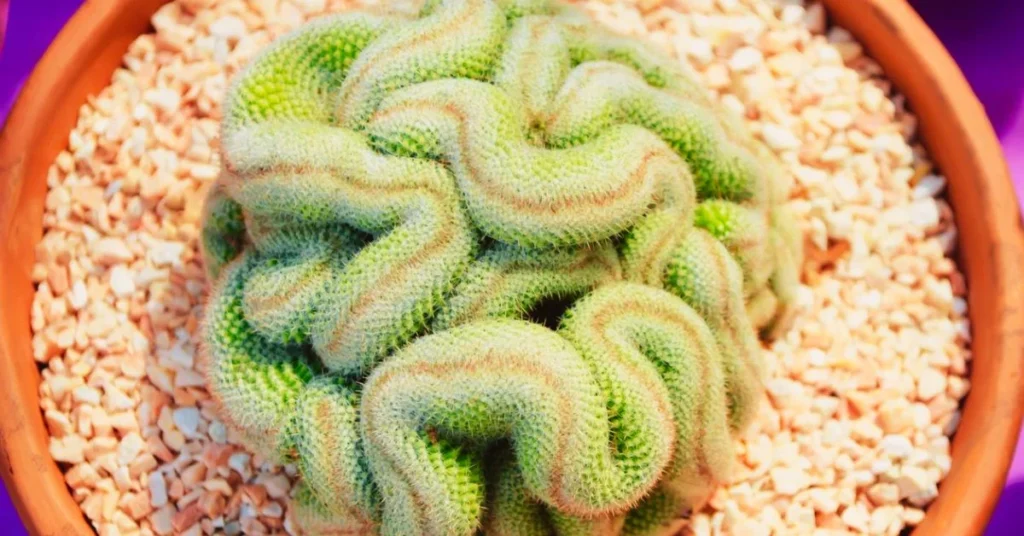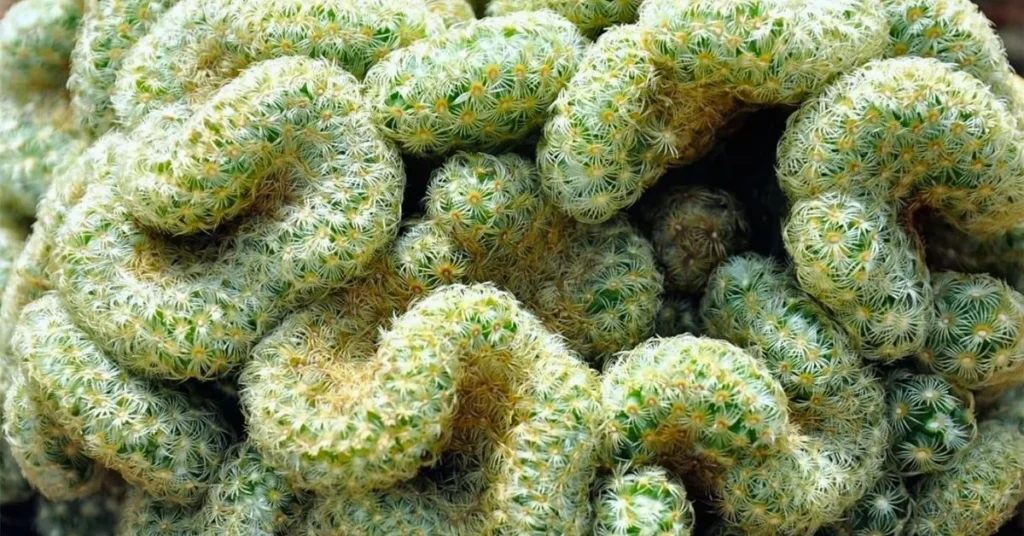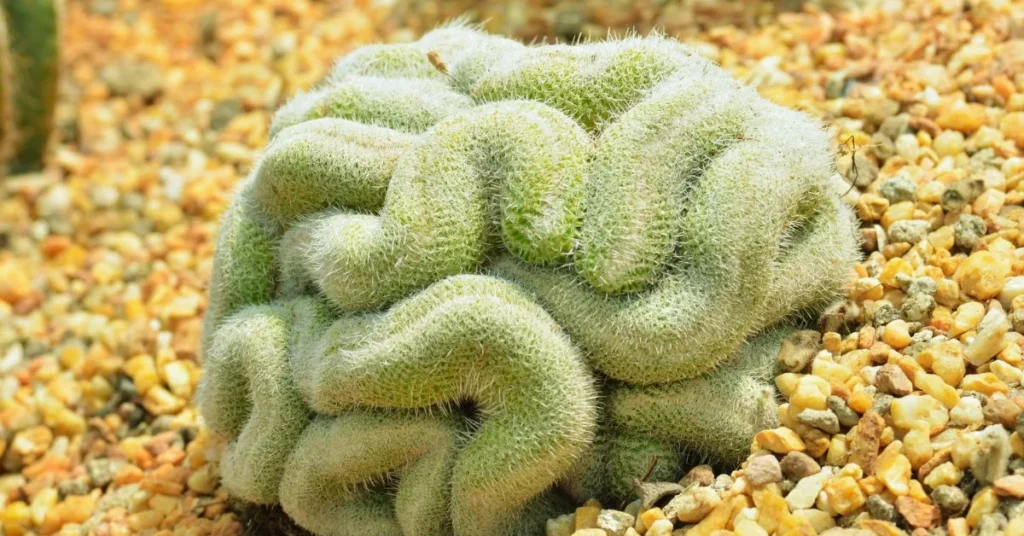In this post, I am going to show you Exactly how to get a Brain cactus and make it a golden piece of your room with little care.
This cactus is not from super generic cacti, and you’ll love to add it to your cactus family.
You are going to learn the following:
- Interesting Facts
- Easy way of propagation
- Care tips
- Related problem and effective solutions
- And
- Buying guide
Let’s deep dive in:
Brain Cactus (Fun and Facts)
Brain cactus is a scary cactus with a brain-like shape. Its scientific name is Stenocactus multicostatus. The exotic houseplant has brain-like ridges due to its twisted stem. Overall, it is round in shape.
Brain cactus is a mutant of the Mammillaria elongata cristata. The native area of the Brain cactus is central Mexico. You can spot them in the rocky outcroppings in the wild of Mexico.
Mammillaria elongata cristata is a colorful household plant that can be used as an outdoor specimen. The convoluted growth is the result of the manual damage to the cells. The injured cells then grow faster in a twisted form.
Brain cactus is a small plant that can grow up to six inches ( fifteen centimeters ) in height and a width of twelve inches (thirty-one centimeters ). Its color is green, but due to the hair-like fine spines, they appear grayish.
Sometimes, there might be flowers that give pink, dark purple, or bright white color.
There are small pink, bell-shaped blooms in the sunshine. Due to their lipophilic nature, they only blossom in the proper sunshine in an open area.
Brain cacti remain dormant when the temperature is lower than 15° C / 59° F. The dormancy period of this cactus species occurs between two to four months.
Brain Cactus Propagation
The propagation of the Brain cactus is quite different from others. It requires a few inventive techniques to propagate.
There are a couple of ways to propagate this Mammillaria elongata cristata. But here we will discuss only the most easy and simple method of propagation.
- Cut the offsets from the mother plant.
- Remove all the pulps from that part while leaving a few roots attached to it.
- Let that part form a callus.
- Then, plant the offset in the pot.
Key insights
While propagating, you have to use a sterile, sharp blade. Furthermore, there should be minimal harm to both parties. In the post-separation phase, you should allow the offsets to dry and form a callus over them.
You have to maintain the warmth and moisture during the whole time of germination. Once the seedlings appear, transfer the plant to the area of continuous sunlight.
Repotting Brain Cactus

When your cactus doubles its size every two to three years, you should change its pot. During repotting, you should follow a few tips given below.
- Wear thick gloves for protection from spines.
- Use a sharp and sterilized knife.
- Let the soil of the pot dry.
- Now, tilt the pot and remove the plant gently.
- Trim the dead roots from the cactus gently.
- Fill the new pot with only a base layer of cactus soil mixture.
- Place it in the new pot and put cactus soil around the sides of the plant.
The key insight for perfect repotting
Don’t water the plant for a few days and let it adapt to the new habitat. Avoid direct sunlight to your plant for some days.
In the spring, there is optimum growth, which is considered the most suitable time for changing the pot. Moreover, you can wait for the roots to prune from the holes of the pot.
Brain Cactus Care
If you are a Brain cactus lover, you should follow the following care tips.
Soil
As it is a plant of rocky areas, it will require a sandy, gritty, and well-draining soil mixture. You can use sand or fine pumice in your cactus pot. Overwatering can destroy your cactus by rotting the roots. That’s why you should use the mixture with the best drainage ability.
Light
The native area of the Mammillaria elongata cristata is sunny and warm. Therefore, for their optimal growth, you have to keep them in sunlight for almost six hours per day. In this sunlight, cactus plants and their flowers will reach their full potential.
Temperature
Mammillaria elongata cristata need a minimum of 10° C / 50° F to thrive.
- In summer, these plants grow best at above 21° / 70° F.
- During winter, the cactus can thrive between 10° and 15.5° C / 50° and 60° F.
Water
They will need a very small amount of water. Their cells can withstand longer periods of drought.
- In summer, these plants should be watered only when they are completely dried out.
- In winter, you should water them only once a month. This season is mostly a dormant phase for these cacti; therefore, they don’t require water for growth.
Key insight
Extra water can very quickly kill your cactus. Therefore, a pot with proper draining holes should be preferred so that the extra water is drained out from the roots.
Pot
There are several types of pots in the market, such as Terracotta, ceramic pots, plastic pots, and glass pots. However, one thing must be kept in mind that the pot is porous. That will allow air and moisture to pass easily and your cactus will not drown in moisture. On the other hand, non-porous pots are very harmful to the cactus.
As the Terracotta and ceramic pots come with porous walls, they are preferable to others.
Fertilizer
Brain cacti acquire their energy from the sunlight. They don’t really need fertilizer to increase their growth. The change of soil once a year is enough to fulfill the need for nutrients. However, you can use a liquid fertilizer during spring or summer when they have maximum growth.
If you really want to fertilize your Mammillaria elongata cactus, you can use the fertilizer with a low nitrogen ratio. The fertilizer with NPK of ratio 1:1:2 is suitable for the cactus. Moreover, you can go for organic fertilizer such as home cooked food or fast food.

Brain Cactus Problems
Softness and discoloration of the leaves are caused by the over-watering. Moreover, it can cause root rotting. It is treated with proper watering regulations.
Leaves of the cactus wrinkle and contract due to underwatering. Watering the plant once a month can cure this problem.
Sometimes, brown spots appear on the leaves. It is due to prolonged sunlight exposure. Avoid keeping the plant in the sunlight for more than six hours a day.
Honeydew and cottony clusters are formed on the cactus due to the mealybugs and scale insects. Hydrogen peroxide is mostly used to kill these insects.
Fungus in the form of mold and mildew can also cause discoloration. There are fungicides that act like a shield against them.
Brain Cactus Price
The estimated price of the Brain cactus is $35. You can buy it from online stores. But make sure to check the reviews, ratings, and best prices from different stores before buying. Or if you want to buy them physically, there are many shops and stores that sell these cacti.
Here you have it:
Brain Cactus with its in-depth details
So what have you decided?
Are you going to add?
Or
Do you have another species that you like more than it?
Whatever your answer is, let me know in the comment box.
